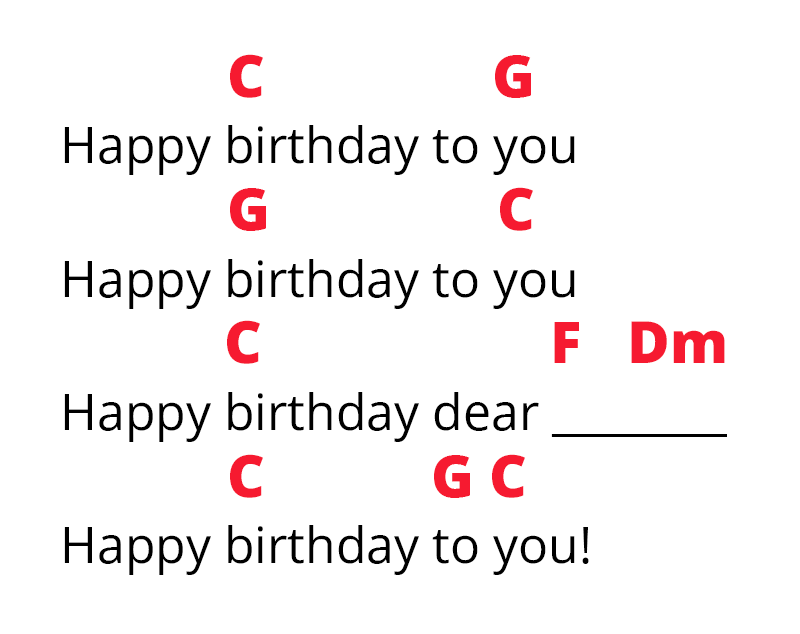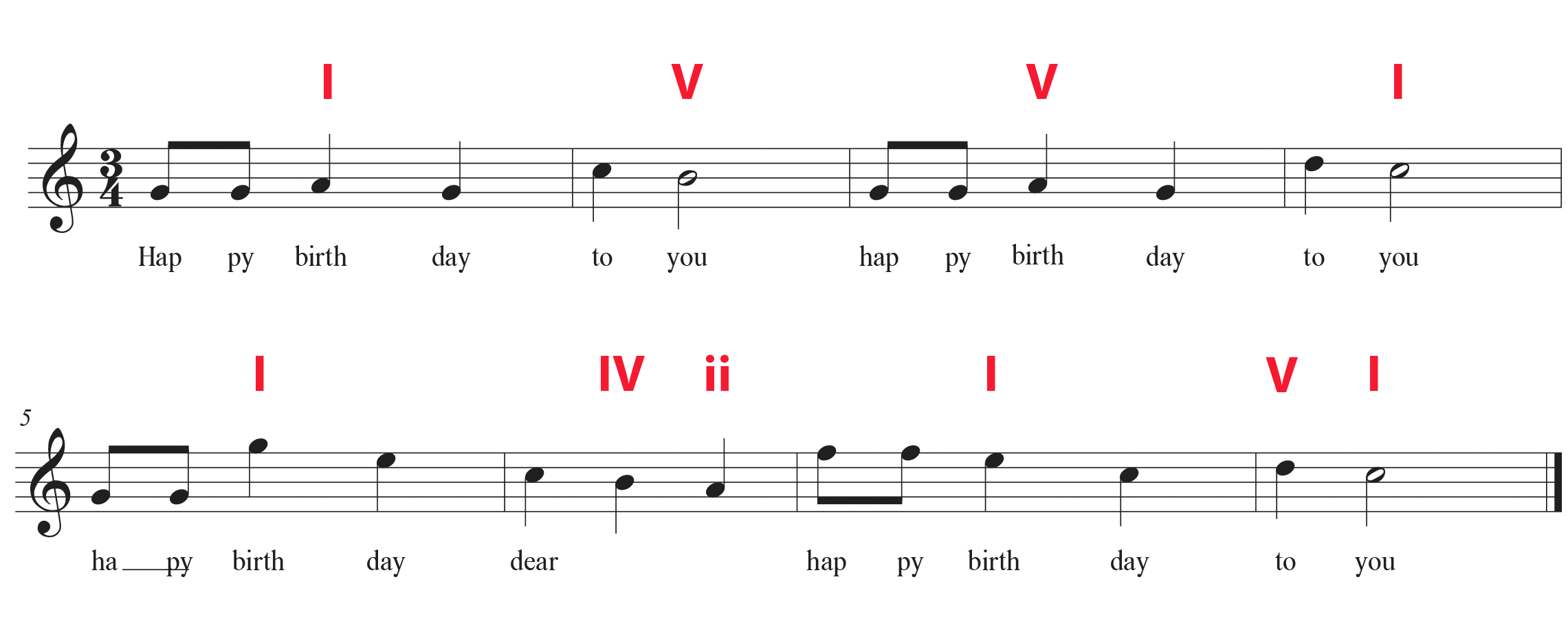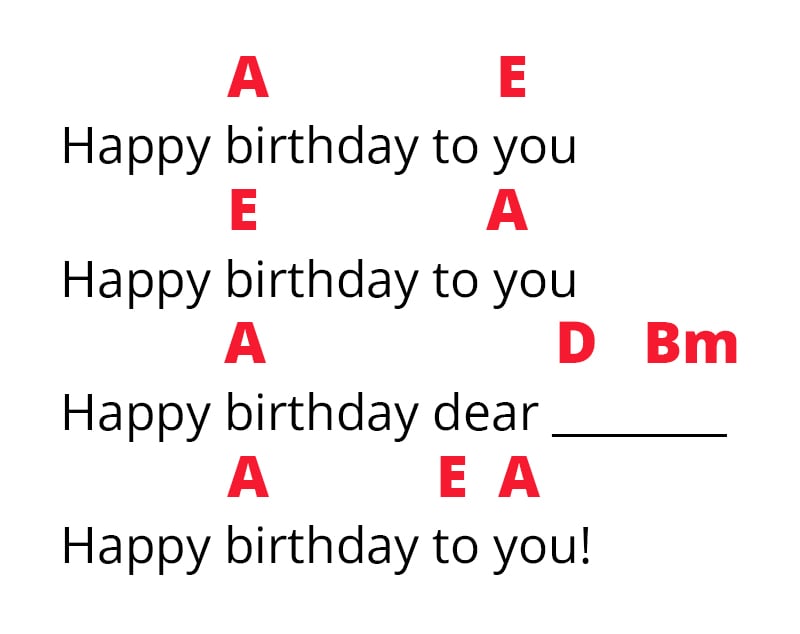Recently, a friend of mine admitted that he didn’t know the piano chords to “Happy Birthday” on the piano. He was at a birthday party, there was a piano there, and people knew that he played. So, they asked him to play “Happy Birthday,” but he didn’t know how!
And get this — it happened more than once!
In this lesson, I’ll show you how to play “Happy Birthday” on the piano in C Major in its easiest form. Then, I’ll show you how to play a jazzy version. Super simple but it sounds so nice!
Table of Contents:
Get exclusive interviews, fascinating articles, and inspiring lessons delivered straight to your inbox. Unsubscribe at any time.
To play “Happy Birthday” on the piano in C major, you only need four piano chords: C, G, F, and Dm. Here’s a diagram of all of them in root position:
C Major Triad
C-E-G

F Major Triad
F-A-C

G Major Triad
G-B-D

D Minor Triad
D-F-A

We’ve also made a lead sheet of the melody and chords:
> Download Happy Birthday Piano Chords & Lead Sheet
The easiest way to play “Happy Birthday” is to play the melody on your right hand and the chords on your left. We’ve written our lead sheet in C Major, but pay attention — the song actually starts on G!
To do this, just change chords whenever they appear above a point in the melody:

You can also think of it as changing chords over words:

Before you go further, we recommend practicing the easy version of “Happy Birthday” a few times first. Get to know these chords.
If you (or your party) find this key too high or too low to sing, keep reading to learn how you can transpose it.

If you struggle with reading music, you’re not alone! Did you know you can play hundreds of songs without standard notation? We’ll show you the secrets traditional lessons won’t teach in a 100% free webinar. It’s open to all ages and ability levels. Just show up and have fun!
Playing “Happy Birthday” like this is fine and dandy, but a way to take it up a notch is to jazz it up!
Making something sound “jazzy” can be quite simple: use seventh chords.
What are seventh chords? It’s when you add a fourth note after your triad that is seven notes away from the root (or bottom) chord.
Now, here’s an important thing to remember: stay in your key. We’re in C Major, which means no sharps or flats, so don’t add a note that gets a sharp or flat onto your seventh. Here are the chords we’ll use:
Cmaj7
C-E-G-B

Fmaj7
F-A-C-E

G7
G-B-D-F

Dm7
D-F-A-C

You’ll notice some of the chords have “maj” in them and some of them don’t. The “maj” means the chord isn’t a dominant seventh, while the lack of a “maj” means the chord is a dominant seventh.
A dominant seventh chord is a chord that’s built on the seventh note of a scale. For example, take C7: count backwards to five from C and you’ll land on F. This means C7 is a dominant seventh chord built on the fifth note of F Major.
What difference does this make? Well, F Major has one flat: B flat. This makes C7 a chord with the notes C-E-G-Bb.
Meanwhile, Cmaj7, a non-dominant seventh chord, has the notes C-E-G-B. You can learn more about different types of seventh chords here.
So far, we’ve been playing all our chords in root position. But you can mix up the order of notes in your chords using inversions.
You’ll notice I play a G7 chord in 2nd inversion at the end. That is, the G7 chord is ordered D-F-G-B. Can you see how I get to move less by using this inversion? Inversions can help us transition smoothly between chords!
You can learn more about inversions here and how to use them as shortcuts here. Here are more ideas to make your “Happy Birthday” performance more impressive:
Now, we’ve been playing (and perhaps singing!) “Happy Birthday” in C Major. But not everyone is comfortable with singing in C Major. So, it helps to learn how to transpose (move into a different key).
If you want to learn how to transpose, it helps to learn the number system.
Each chord gets a number. Our starting key is C Major, so recall that the C Major scale goes like this:
C-D-E-F-G-A-B
Since our C chord is built on the first note of the C Major scale (C), it gets the number 1 or I.
The chord is built on the fifth note of the C Major scale, so it gets the number 5 or V.
Our F chord is built on the fourth note of the C Major scale, so its name is IV.
Dm is built on the second note of the C Major scale, so it becomes our ii chord. (Note: uppercase letters represent major chords and lowercase letters represent minor chords.)
So, in number form, our lead sheet now looks like this:

Now, let’s use these numbers to transpose our song.
Say C Major is too high for you (maybe you have a party full of baritones!). Let’s transpose everything down to A Major.
Here’s the A Major scale:
A-B-C#-D-E-F#-G#
So, our I chord becomes a chord built on the first note of the scale. This is the A chord (A-C#-E).
Our V chord becomes an E chord (E-G#-B).
Next, our IV chord turns into a D chord (D-F#-A).
Finally, the ii chord is now Bm (B-D-F#).
Now you have a transposed song:

That’s all there is to it! Try it yourself. Transpose everything in the opposite direction: up to E Major. Then, scroll to the bottom of this article to see if you got the chords right!
Here’s your final challenge: find out when your next birthday party will be, and then play “Happy Birthday” for everyone there!
For extra pizazz, memorize the song. (Don’t worry, it’s not too long!).
And don’t be like my friend. Learn “Happy Birthday.” (Looking at you, Scott!).
Happy practicing 🙂
Get real feedback from real experts…all from the comfort of your own home. Explore our Method and community for yourself with a free trial.
Chords in E Major: I = E, V = B, IV = A, ii = F#m
Lisa Witt has been teaching piano for more than 20 years and in that time has helped hundreds of students learn to play the songs they love. Lisa received classical piano training through the Royal Conservatory of Music, but she has since embraced popular music and playing by ear in order to accompany herself and others. Learn more about Lisa.
/marketing/pianote/lead-gen/getting-started/coach.webp)
/marketing/pianote/lead-gen/getting-started/logo.webp)
By signing up you’ll also receive our ongoing free lessons and special offers. Don’t worry, we value your privacy and you can unsubscribe at any time.
We use cookies for traffic data and advertising. Cookie Policy »
/marketing/pianote/lead-gen/digital-chords-and-scales/blog-exit-m.png)
Grab a FREE E-Book with every Chord and Scale you’ll need to play your favorite songs.
Enter your email and we’ll send your book instantly.
Don’t worry, we value your privacy
and you can unsubscribe at any time.